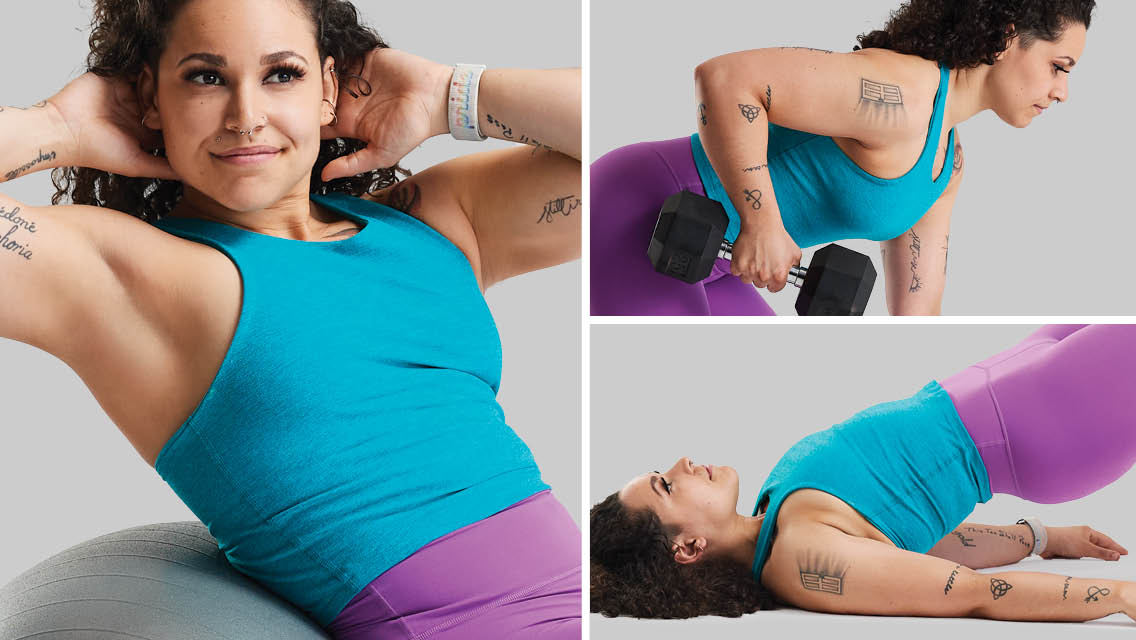Explore this article:
When you’re strength training, nothing beats a progressive, periodized program that aligns with your goals and fitness level. But sometimes — say, when you’re traveling, when life throws you a scheduling curveball, or when you simply want to mix things up with a new challenge — it can be helpful to go off-plan rather than skip exercising altogether. That’s where ladder workouts truly shine.
Not to be confused with agility ladder workouts, the “ladder” here refers to an ascending or descending rep scheme to rack up volume in a short period of time without requiring much, or any, weight. It’s an efficient, effective way to train conditioning and strength endurance.
To get started, give one of these ladder schemes and sample workouts a try.
1) Ascending Ladder
This is a rep scheme that increases in consistent intervals. You can add any number of reps — one, two, three, and so on — but the key is that the increases are not random. You can apply this to a single exercise using a single weight, a single exercise using multiple weights, or a circuit of multiple exercises using the same weight. Starting with low reps provides a built-in warm-up and gives you the chance to groove the movement pattern before doing higher reps.
1a) Single-exercise, single-weight ascending ladder
- Set up one kettlebell for kettlebell swings; the weight you choose is the weight you’ll stick with.
- Perform one swing and set the bell down.
- Reset, then perform two swings, and set the bell down.
- Reset, then perform three swings, and set the bell down.
- Continue increasing the reps in each set by one.
You can set a time limit — for instance, stop after five minutes. Or you can cap the reps of the final set — say, stop after you’ve completed a set of 10 or 20 reps. Pace yourself and rest as needed between rounds. (Optimizing how you rest during your workout can help you reach your fitness goals. Here’s why.)
1b) Single-exercise, multiweight ascending ladder
- Set up three sets of dumbbells — heavy, medium, and light — for floor presses.
- Perform five reps with the heavy weights, then 10 reps with the medium weights and 15 reps with the light weights.
- Pace yourself, and rest as needed between rounds.
- Repeat the circuit up to three times, if desired.
1c) Multimove, single-weight ascending ladder
- Set up a single barbell, or set of dumbbells, to perform a circuit of deadlifts, bent-over rows, and thrusters (see this article for thruster form tips; this will be the limiting exercise for most people, so choose a weight that feels slightly challenging and use that same weight for all three movements).
- Set a timer for 12 minutes.
- Perform three reps of each exercise, in order, then six reps, then nine reps, then 12 reps, and so on, increasing in intervals of three until time is up.
- Pace yourself and rest as needed between rounds.
2) Descending Ladder
This is a rep scheme that decreases in consistent intervals. As with the ascending ladder, the reps can decrease by any number, and this scheme can be used for single exercises and multi-move circuits. For many people, doing fewer reps with each round makes it psychologically more approachable.
2a) Single-exercise, single-weight descending ladder
- Prepare to perform pull-ups, using assistance (with resistance bands or your feet) as needed to make the following rep count accessible. (For tips and photos on variations for this move, see “4 Steps to Your First Pull-Up.”)
- Perform 10 pull-ups.
- Release the bar and reset, then perform eight pull-ups.
- Release the bar and reset, then perform six pull-ups.
- Continue decreasing the reps by two in each set until you’ve completed a set of two.
- Pace yourself and rest as needed between rounds.
2b) Single-exercise, multiweight descending ladder
- Set up three kettlebells — heavy, medium, and light — for deadlifts. (See “How to Do the Romanian Deadlift” for instructions of this move.)
- Perform 15 reps with the light bell, then 10 reps with the medium bell and five reps with the heavy bell.
- Pace yourself, and rest as needed between rounds.
- Repeat the circuit up to three times, if desired.
2c) Multimove, single-weight descending ladder
- Set up to perform a circuit of body-weight squats, sit-ups, pushups, and burpees.
- Perform 10 reps of each exercise, in order.
- Then nine reps, then eight reps, and so on, ending with one rep of each move.
- Pace yourself and rest as needed between rounds.
3) Ascending-Descending Ladder
Finally, you can combine the ascending and descending schemes to create a longer or more challenging workout. There are a few different ways to approach this ladder style, largely depending on how many exercises you want to incorporate.
3a) Pyramid ascending-descending ladder
This approach features reps that increase in consistent intervals until reaching a predetermined rep or time cap, then decreases in the same consistent intervals. Pyramid workouts work particularly well when doing a single movement.
Ascend:
- Set up to perform body-weight reverse lunges.
- Perform one reverse lunge per leg.
- Reset, then perform two reverse lunges per leg.
- Reset, then perform three reverse lunges per leg.
- Continue increasing the reps in each set by one. You can set a time limit (five minutes, for instance) or cap the reps (say, 10 lunges per leg).
Descend:
- Then reverse the rep count to complete the descending ladder.
- Decrease the repetitions in each round by the same original number.
- Pace yourself and rest as needed between rounds.
3b) Waving ladder
This version is best for circuits of two exercises. The rep scheme for one exercise will increase each round while the reps for the other exercise will decrease.
- Set up a single kettlebell to perform goblet squats and cleans. You’ll use the same weight for both movements, so choose one that is challenging but doable for both.
- In the first set, perform two reps of the goblet squat and 10 reps of the kettlebell clean.
- Then perform four reps of the goblet squat and eight reps of the kettlebell clean.
- Continue in this fashion, increasing the number of goblet squats and decreasing the number of kettlebell cleans by two per round.
- Complete the workout with a set of 10 goblet squats and two kettlebell cleans.
- Pace yourself and rest as needed between sets.
3c) 12 Days ladder
Yet another approach to ascending-descending ladders is called a 12 Days ladder — a riff on the song “The 12 Days of Christmas.” Despite its name, this routine is not spread out over 12 days — it’s done in one continuous session during which a rep count of one to 12 is assigned to a specific movement and, like in the song, every move is repeated in each round. (While it often pops up during the winter holiday season, this workout is a fun challenge any time of year and can be adapted for any number of exercises other than 12.)
Here’s an example of a 12 Days ladder:
- Star jump
- Turkish get-up (per side) (see the first move in this workout for directions)
- Inverted row
- Deadlift
- Pushup
- Inchworm
- Squat jump
- Gorilla row (per side) (here’s how to do the gorilla row)
- Walking lunge (per side)
- Kettlebell swing
- Glute bridge
- Mountain climber (per side) (and here’s how to do a mountain climber along with several variations)
How to do a 12 Days ladder:
- Set up multiple sets of dumbbells or kettlebells, or prepare to use body weight only, as needed for each movement.
- Begin with one star jump.
- In the second round, you’ll do two Turkish get-ups per side, then one star jump.
- In the third round, you’ll do three inverted rows, two Turkish get-ups per side, then one star jump.
Continue in this fashion until the last round, when you’ll complete 12 mountain climbers per side, 11 glute bridges, 10 kettlebell swings, nine walking lunges per side, eight gorilla rows per side, seven squat jumps, six inchworms, five pushups, four deadlifts, three inverted rows, two Turkish get-ups per side, and, finally, one star jump.
Pace yourself and rest as needed between sets.
This article originally appeared as “Learn to Love the Ladder” in the July/August 2024 issue of Experience Life.





This Post Has 0 Comments